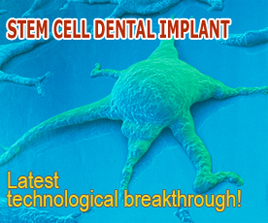|
|
Dental Implant

Dental implants replace missing teeth and are titanium screws that are placed into the jaw bone to support a crown, bridge or denture.
Dr. Lem has over 20 years of dental implant experience and routinely attends conferences around the country to keep current on the latest dental implant developments.
Don't miss life because of missing teeth, say YES to dental implant!
Immediate Implants
An implant that is placed on the same day that a tooth is extracted is called an immediate implant. These are attractive to patients because it can reduce the number of surgeries that are required, minimize the use of temporary dentures, and may decrease the amount of treatment time and follow-up until the final restoration is finished. Some implant “clinics” use the immediate implant as a marketing strategy to attract more patients. These “clinics” extract teeth, place bone substitutes, place implants and restorations on the same day. Prudent patients need to beware of the disadvantages.
The disadvantage of immediate implants is that treatment is more expensive and involves more risk of implant failure. After a tooth is extracted, the remaining socket may have an infection or surrounded by thin bone. Thin bone or an active infection can lead to implant failures. The i-CAT X-ray can help decide if you are a good candidate for an immediate implant. The i-CAT can examine the prospective implant site on the jaw to determine if there is enough bone height, width and density. If the socket has an infection, it is safer to delay the implant placement. If the jaw bone is too thin, a bone graft will be necessary. A bone graft can increase the size of the bone ridge so the implant will be strong and serviceable for many years. This bone graft will usually take a few months to heal before it is hard enough to accept an implant. Therefore, an immediate implant may not be a wise decision for some patients.
Sterile Technique
Sterile technique is the effort taken to keep patients as free from micro-organisms as possible. It is a method used to prevent contamination of wounds and other susceptible sites by organisms that could cause infection. This can be achieved by ensuring that only sterile equipment and fluids are used during procedures. Prior to an implant or bone grafting procedure the assistant will instruct the patient on changing into a gown, hair covering and shoe covers and will have the patient rinse their mouth out with a bacteria killing mouth wash. After the surgical site has been numbed or I.V. sedation administered the assistant will apply an antibacterial solution (Betadine) to the skin of the face and neck to ensure that the area is free of infection causing germs. Dr. Lem then “drapes” the patient or covers the patient with sterile towels and a sheet that are all germ free. Also, all of the instruments used for the procedure are opened onto a sterile tray and without being touched by non-sterile hands. Prior to beginning the procedure both Dr.Lem and his assistant change into sterile gloves.
|
|

News & Events
|
Stem cells are cells found in most, if not all, multi-cellular organisms. They are characterized by the ability to renew themselves through mitotic cell division and differentiating into a diverse range of specialized cell types.
|
|
A research suggests that coating dental implants with a synthetic bone material prior to implantation allows such implant to become incorporated much more successfully into the jaw, leading to smiles all round.
|
|
The results of experiments that focused on 'nanostructures'demonstrated enhanced bone response to dental implants as soon as 4 weeks after implant placement.
|
Newsletter
|